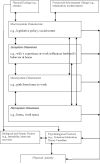Building a multiple modality, theory-based physical activity intervention: The development of CardiACTION!
- PMID: 22473308
- PMCID: PMC3004469
- DOI: 10.1016/j.psychsport.2010.04.012
Building a multiple modality, theory-based physical activity intervention: The development of CardiACTION!
Abstract
OBJECTIVES: Despite the widely acknowledged benefits of regular physical activity (PA), specific goals for increased population levels of PA, and strongly recommended strategies to promote PA, there is no evidence suggesting that the prevalence of PA is improving. If PA intervention research is to be improved, theory should be used as the basis for intervention development, participant context or environment should be considered in the process, and intervention characteristics that will heighten the likelihood of translation into practice should be implemented (e.g., ease of implementation, low human resource costs). The purpose of this paper is to describe the implementation of the aforementioned concepts within the intervention development process associated with CardiACTION an ongoing randomized 2 × 2 factorial trial. METHODS: The Ecological Model of Physical Activity integrated with Protection Motivation Theory was used to inform the design of the interventions. This integrated model was selected to allow for the development of theory-based individual, environmental, and individually + environmentally targeted physical activity interventions. All intervention strategies were matched to proposed mediators of behavior change. Strategies were then matched to the most appropriate interactive technology (i.e., interactive computer session, automated telephone counseling, and tailored mailings) delivery channel. CONCLUSIONS: The potential implications of this study include determining the independent and combined influence of individual and environment mechanisms of behavior change on intervention effectiveness. In addition, all intervention models are developed to be scalable and disseminable to a broad audience at a low cost.
Figures
References
-
- Baron RM, Kenny DA. The moderator-mediator variable distinction in social psychological research: conceptual, strategic, and statistical considerations. Journal of Personality and Social Psychology. 1986;51 - PubMed
-
- Bauman AE, Sallis JF, Dzewaltowski DA, Owen N. Towards a better understanding of the influences on physical activity: the role of determinants, correlates, causal variables, mediators, moderators, and confounders. American Journal of Preventive Medicine. 2002;23:5–14. - PubMed
-
- Bertera RL. Behavioral risk factor and illness day changes with workplace health promotion: two-year results. American Journal of Health Promotion. 1993;7:365–373. - PubMed
-
- Blair SN, Piserchia PV, Wilbur CS, Crowder JH. A public health intervention model for work-site health promotion. Impact on exercise and physical fitness in a health promotion plan after 24 months. JAMA. 1986;255:921–926. - PubMed
-
- Borresen J, Lambert MI. Autonomic control of heart rate during and after exercise : measurements and implications for monitoring training status. Sports Medicine. 2008;38:633–646. - PubMed
Grants and funding
LinkOut - more resources
Full Text Sources




